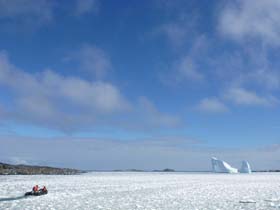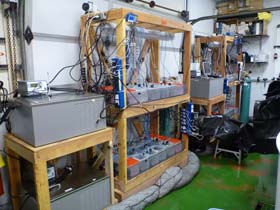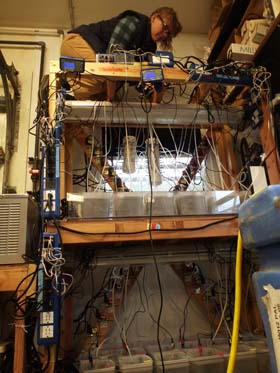
If you have been following our progress so far this season, you may have noticed that we have been covering a wide variety activities and projects in these first several weeks of our field season. The climate change grant that brought us down here to complete our research this (and last) year is a very ambitious research project. Just as a quick reminder, we will (and did last year) examine some of the effects of ocean acidification (decreased pH due to increased atmospheric CO2 concentrations) and increased temperatures. We are interested primarily in how the changing environment down here might affect the benthic (sea floor-dwelling) invertebrates and algae. (There will be lots more detail on this later.)
Right now, I want to give you a sneak peak into how we are going about creating a controlled system where we can precisely control the temperature and pH to find some answers to our climate change questions. As you may imagine, this quickly becomes complicated because we are trying precisely control physical variables (temperature and pH) that tend to change quickly with changing conditions in a rather harsh environment.
In order to maintain control of our colder target water temperatures (1.5oC or 3.5oC), we will be performing our experiments out in the Palmer aquarium room, where the room temperature has been around 4oC for the past week. Since we arrived here at Palmer Station, we have been working long hours out in the aquarium, getting everything set up for the experiment. Many of those hours have been quite chilly, especially when you have your hands in the water for even short amounts of time.
Setting up the experiment has included all of the things that Kevin, Maggie, Chuck and Kate have already discussed, including but not limited to collecting and subsequent sorting of amphipods and algae, PAM readings, and water chemistry parameterization. That means a lot of work and plentiful multitasking days for all of us. Today, I would like to focus a little more on the physical set up of our experiment.

It’s hard to imagine now, but only a few weeks ago, these were just two sets of bare shelves. Each year we have built up everything that we will need to perform our OA/temperature experiments on these shelves. That is the nature of performing research at a field station, you have a limited amount of space available to you and it is shared throughout the year with a wide variety of other researchers doing a wide variety of experiments. At the beginning of the season we build it all up and right before we leave, we pack it all away again.
To control the temperature of our experimental treatments we are using large water baths to circulate water of a pre-set temperature. As you can see in the picture, those big grey water baths are hooked up to plexi-glass water tables that hold our experimental microcosms (the containers that hold our experimental organisms) and keep the temperature stable.
In addition to controlling the temperature, we are also controlling the pH by bubbling a CO2-air mixture directly into each of our microcosm containers (hence all of the tubing and pH-probes). We have a programmed computer system that monitors the pH of each of our experimental pH microcosms and changes the amount of CO2-air mixture delivered to each container based on information provided by the pH probes.
Kate and I spent most of the day today monkeying around with the experimental set-up, adjusting everything to ensure that the computer programming is doing what we want it to do.

We have been tweaking this set up since we arrived. This process includes ensuring that the water chemistry (by testing the seawater pH and total alkalinity) in each microcosm is being maintained at our target levels. In addition to all of this we are also doing checks of the lighting, temperature, and going over the whole set up to make sure nothing is leaking.
Each of these steps can be very tedious and time-consuming. We are fortunate to have a field team with such a wide background of knowledge and experience. It has allowed us greater flexibility in putting all of the many experiment pieces together to get this experiment off the ground, so to speak. If any one of us had to do this all on our own, it would take at least 6 months to accomplish what we have gotten done in under a month.
Hopefully after this brief introduction of our experimental set-up, you will have a better idea of the context in which we are working once we get everything up and running soon. We are in the final stages of checking everything and making sure that we have everything we need to start this experiment. I am excited to see everything coming together.
Got questions, comments? Contact us at